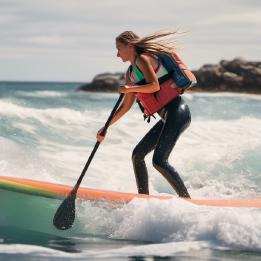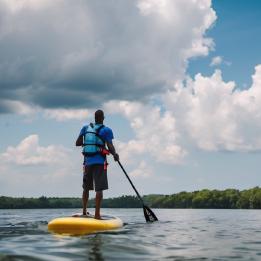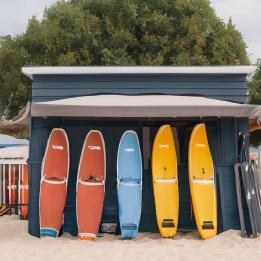Paddle Your Way to Peak Fitness: 7 Effective Strategies for Getting in Shape for Stand-Up Paddleboarding

Ready to catch waves but not in paddleboarding shape yet? Use these SUP fitness tips to get your body ready to ride the seas with strength and stamina. With the right training, you’ll be shredding in no time!
Build a Strong Paddleboarding Core
Having a solid core is crucial for balancing on a SUP and powering through choppy water. Planks, crunches, and other core moves will increase stability. Yoga is another great way to build core muscles.
Focus on strengthening your abs, back, hips, and glutes for best results. A strong paddleboarding core lets you dig deep when conditions get tough.
Core strength is the foundation of great SUP technique
Improve Leg Strength for Stability
Your leg muscles propel the board and support your stance, so they need to be toned. Squats, lunges, and cycling are excellent for developing strong paddleboarding legs.
Target your quads, hamstrings, and calves to stay balanced on the board through any waters. Strong legs also aid in stability when ocean swells get big.
Develop Shoulder and Arm Endurance
Paddling uses major upper body muscles - especially your shoulders, triceps, back, and lats. Weight training builds the endurance needed to dig in paddle stroke after paddle stroke.
Try shoulder presses, rows, push-ups and pull-ups. Yoga flows that incorporate arm balances are also very effective for honing shoulder stability.
Increase Cardiovascular Fitness
Paddleboarding is a demanding full-body cardio workout. Boost your endurance with running, swimming, cycling, or HIIT routines.
Improved cardio fitness lets you paddle longer and recover faster between SUP sessions. It also helps prevent muscle fatigue when battling winds and currents.
Improve Flexibility for Ease of Movement
Limber muscles move fluidly through paddle strokes and balance poses. Stretch regularly to enhance flexibility and reduce injury risk.
Focus on major muscle groups like hamstrings, shoulders, back, and hips. Yoga is ideal for building paddleboarding flexibility. Increased mobility maximizes your performance.
Cross Train With Yoga and Pilates
Yoga and Pilates wonderfully complement paddleboarding. They build strength, balance, core stability, and flexibility.
Flows and poses that require balance are especially helpful. Work towards arm balances like crow pose to develop shoulder endurance. Cross training reduces injury risk while enhancing your abilities.
Listen to Your Body
Recovering properly is just as important as training. Let your muscles rest after tough workouts to avoid injury. Refuel with healthy nutrition and proper hydration too.
Slowly increase difficulty as your fitness improves. By tuning into your body’s needs and pacing yourself, you’ll be paddleboarding in peak condition in no time!
Get our full guide to SUP for beginners →
Roundup: Key Focus Areas
Follow these SUP fitness tips to maximize your paddleboarding performance:
- Build a strong core with planks, crunches and yoga
- Strengthen legs for power and stability
- Develop shoulder and arm endurance to dig paddle strokes
- Improve cardiovascular fitness for increased endurance
- Enhance flexibility through regular stretching
- Cross train with yoga and Pilates
- Listen to your body and recover properly
Keep these focus areas in mind when tailoring your training regimen. With the right preparation, you’ll be shredding waves in peak physical condition.
With these effective SUP fitness tips, you’ll build the strength, balance, and endurance needed to master the seas. Stay motivated by setting goals, training with friends, and visualizing your paddleboarding success. See you on the water!



